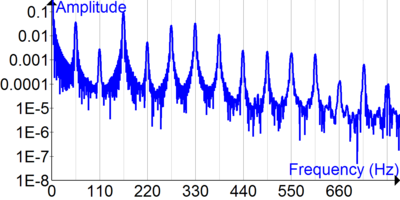Furijeova analiza — разлика између измена
. |
(нема разлике)
|
Верзија на датум 27. јун 2019. у 11:07


U matematici, Furijeova analiza[1] je proučavanje načina na koji se opšte funkcije mogu predstaviti ili aproksimirati sumama jednostavnijih trigonometrijskih funkcija. Fourierova analiza je izrasla iz proučavanja Furijeovog reda i nazvana je po Žozefu Furijeu, koji je pokazao da predstavljanje funkcije kao sume trigonometrijskih funkcija uveliko pojednostavljuje proučavanje prenosa toplote.
Један корисник управо ради на овом чланку. Молимо остале кориснике да му допусте да заврши са радом. Ако имате коментаре и питања у вези са чланком, користите страницу за разговор.
Хвала на стрпљењу. Када радови буду завршени, овај шаблон ће бити уклоњен. Напомене
|
U današnje vreme, predmet Furijeove analize obuhvata a vast spectrum of mathematics. In the sciences and engineering, the process of decomposing a function into oscillatory components is often called Fourier analysis, while the operation of rebuilding the function from these pieces is known as Furijeova sinteza. For example, determining what component frequencies are present in a musical note would involve computing the Fourier transform of a sampled musical note. One could then re-synthesize the same sound by including the frequency components as revealed in the Fourier analysis. In mathematics, the term Fourier analysis often refers to the study of both operations.
The decomposition process itself is called a Furijeova transformacija. Its output, the Fourier transform, is often given a more specific name, which depends on the domain and other properties of the function being transformed. Moreover, the original concept of Fourier analysis has been extended over time to apply to more and more abstract and general situations, and the general field is often known as harmonic analysis. Each transform used for analysis (see list of Fourier-related transforms) has a corresponding inverse transform that can be used for synthesis.
Aplikacije
Furijeova analiza has many scientific applications – in physics, partial differential equations, number theory, combinatorics, signal processing, digital image processing, probability theory, statistics, forensics, option pricing, cryptography, numerical analysis, acoustics, oceanography, sonar, optics, diffraction, geometry, protein structure analysis, and other areas.
This wide applicability stems from many useful properties of the transforms:
- The transforms are linear operators and, with proper normalization, are unitary as well (a property known as Parseval's theorem or, more generally, as the Plancherel theorem, and most generally via Pontryagin duality) Rudin 1990.
- The transforms are usually invertible.
- The exponential functions are eigenfunctions of differentiation, which means that this representation transforms linear differential equations with constant coefficients into ordinary algebraic ones Evans 1998. Therefore, the behavior of a linear time-invariant system can be analyzed at each frequency independently.
- By the convolution theorem, Fourier transforms turn the complicated convolution operation into simple multiplication, which means that they provide an efficient way to compute convolution-based operations such as polynomial multiplication and multiplying large numbers Knuth 1997.
- The discrete version of the Fourier transform (see below) can be evaluated quickly on computers using Fast Fourier Transform (FFT) algorithms. Conte & de Boor 1980
In forensics, laboratory infrared spectrophotometers use Fourier transform analysis for measuring the wavelengths of light at which a material will absorb in the infrared spectrum. The FT method is used to decode the measured signals and record the wavelength data. And by using a computer, these Fourier calculations are rapidly carried out, so that in a matter of seconds, a computer-operated FT-IR instrument can produce an infrared absorption pattern comparable to that of a prism instrument.[2]
Furijeova transformacija je isto tako korisna kao kompaktna reprezentacija signala. For example, JPEG compression uses a variant of the Fourier transformation (discrete cosine transform) of small square pieces of a digital image. The Fourier components of each square are rounded to lower arithmetic precision, and weak components are eliminated entirely, so that the remaining components can be stored very compactly. In image reconstruction, each image square is reassembled from the preserved approximate Fourier-transformed components, which are then inverse-transformed to produce an approximation of the original image.
Reference
- ^ „Fourier”. Dictionary.com Unabridged. Random House.
- ^ Saferstein, Richard (2013). Criminalistics: An Introduction to Forensic Science.
Literatura
- Conte, S. D.; de Boor, Carl (1980). Elementary Numerical Analysis (Third изд.). New York: McGraw Hill, Inc. ISBN 978-0-07-066228-5.
- Evans, L. (1998). Partial Differential Equations. American Mathematical Society. ISBN 978-3-540-76124-2.
- Howell, Kenneth B. (2001). Principles of Fourier Analysis. CRC Press. ISBN 978-0-8493-8275-8.
- Kamen, E. W.; Heck, B. S. (2000-03-02). Fundamentals of Signals and Systems Using the Web and Matlab (2 изд.). Prentiss-Hall. ISBN 978-0-13-017293-8.
- Knuth, Donald E. (1997). The Art of Computer Programming Volume 2: Seminumerical Algorithms (3rd изд.). Addison-Wesley Professional. Section 4.3.3.C: Discrete Fourier transforms, pg.305. ISBN 978-0-201-89684-8.
- Müller, Meinard (2015). The Fourier Transform in a Nutshell (PDF). Springer. In Fundamentals of Music Processing, Section 2.1, p. 40–56. ISBN 978-3-319-21944-8. doi:10.1007/978-3-319-21945-5.
- Polyanin, A. D.; Manzhirov, A. V. (1998). Handbook of Integral Equations. Boca Raton: CRC Press. ISBN 978-0-8493-2876-3.
- Rudin, Walter (1990). Fourier Analysis on Groups. Wiley-Interscience. ISBN 978-0-471-52364-2.
- Smith, Steven W. (1999). The Scientist and Engineer's Guide to Digital Signal Processing (Second изд.). San Diego: California Technical Publishing. ISBN 978-0-9660176-3-2.
- Stein, E. M.; Weiss, G. (1971). Introduction to Fourier Analysis on Euclidean Spaces. Princeton University Press. ISBN 978-0-691-08078-9.
Spoljašnje veze
- Tables of Integral Transforms at EqWorld: The World of Mathematical Equations.
- An Intuitive Explanation of Fourier Theory by Steven Lehar.
- Lectures on Image Processing: A collection of 18 lectures in pdf format from Vanderbilt University. Lecture 6 is on the 1- and 2-D Fourier Transform. Lectures 7–15 make use of it., by Alan Peters
- Moriarty, Philip; Bowley, Roger (2009). „∑ Summation (and Fourier Analysis)”. Sixty Symbols. Brady Haran for the University of Nottingham.
